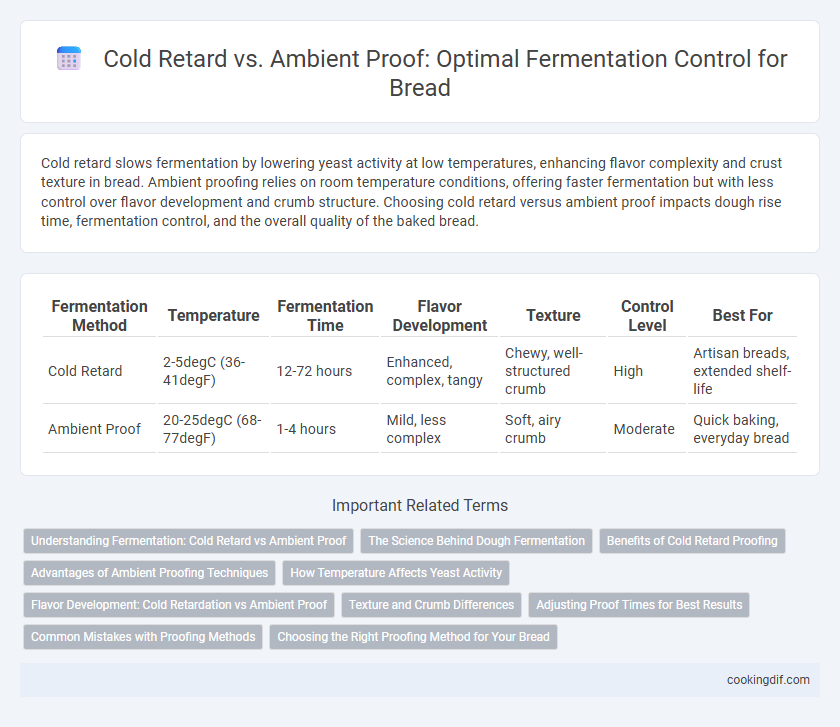Cold retard slows fermentation by lowering yeast activity at low temperatures, enhancing flavor complexity and crust texture in bread. Ambient proofing relies on room temperature conditions, offering faster fermentation but with less control over flavor development and crumb structure. Choosing cold retard versus ambient proof impacts dough rise time, fermentation control, and the overall quality of the baked bread.
Table of Comparison
| Fermentation Method | Temperature | Fermentation Time | Flavor Development | Texture | Control Level | Best For |
|---|---|---|---|---|---|---|
| Cold Retard | 2-5degC (36-41degF) | 12-72 hours | Enhanced, complex, tangy | Chewy, well-structured crumb | High | Artisan breads, extended shelf-life |
| Ambient Proof | 20-25degC (68-77degF) | 1-4 hours | Mild, less complex | Soft, airy crumb | Moderate | Quick baking, everyday bread |
Understanding Fermentation: Cold Retard vs Ambient Proof
Cold retard fermentation slows yeast activity by refrigerating the dough between 35degF to 45degF, enhancing flavor complexity and improving crust texture through prolonged enzymatic reactions. Ambient proofing occurs at room temperature, typically 70degF to 78degF, allowing faster yeast fermentation that results in quicker rise times but less nuanced flavor development. Mastering the balance between cold retard and ambient proofing optimizes gas retention, crumb structure, and overall bread quality for artisanal loaves.
The Science Behind Dough Fermentation
Cold retard fermentation slows yeast activity by lowering the dough temperature to around 4degC, allowing enzymes to break down starches and proteins gradually, enhancing flavor complexity and crust development. Ambient proof fermentation operates at room temperature (typically 20-25degC), accelerating yeast metabolism and CO2 production, which results in faster dough rise but less nuanced flavor profiles. Understanding the temperature-dependent biochemical reactions during fermentation is crucial for controlling crumb texture, gas retention, and overall bread quality.
Benefits of Cold Retard Proofing
Cold retard proofing slows yeast fermentation by maintaining dough at low temperatures, enhancing flavor complexity and fermentation control. This method improves dough structure and extensibility by allowing enzymes and acids to develop gradually, resulting in a superior crumb texture. Extended fermentation also increases shelf life and enhances aroma without overproofing risks common with ambient conditions.
Advantages of Ambient Proofing Techniques
Ambient proofing techniques offer consistent fermentation control by allowing dough to rise at room temperature, which enhances flavor development through slower, natural yeast activity. These methods reduce energy costs and simplify workflow, eliminating the need for refrigeration equipment required in cold retardation. Increased microbial activity in ambient proofing also promotes better crust formation and texture, resulting in artisan-quality bread.
How Temperature Affects Yeast Activity
Cold retard fermentation slows yeast activity by maintaining dough temperatures typically between 2degC to 6degC, allowing flavor development through prolonged fermentation without overproofing. Ambient proofing occurs at room temperatures around 20degC to 25degC, accelerating yeast metabolism and gas production, which shortens fermentation time but may reduce flavor complexity. Understanding temperature's impact on yeast activity is essential for precise control of dough rise, texture, and final bread quality.
Flavor Development: Cold Retardation vs Ambient Proof
Cold retardation slows yeast activity by fermenting dough at low temperatures, resulting in a longer fermentation time that enhances complex flavor compounds and deeper aromatic profiles. Ambient proofing accelerates yeast activity due to warmer conditions, producing faster rise times but often yields milder flavors and less fermentation depth. Optimal flavor development is achieved through controlled cold retardation, allowing enzymatic reactions that enrich the bread's taste and texture.
Texture and Crumb Differences
Cold retard fermentation slows yeast activity by maintaining dough at 4degC to 10degC, resulting in a tighter crumb structure and enhanced flavor complexity due to extended enzyme action. Ambient proofing, typically between 24degC and 27degC, accelerates fermentation, producing a softer, more open crumb with larger air pockets but less developed texture. Cold retardation improves dough extensibility and crust crispness, whereas ambient proofing yields faster results with a tender, airy crumb.
Adjusting Proof Times for Best Results
Cold retard fermentation slows yeast activity by chilling dough between 2-8degC, extending proof times for enhanced flavor and texture development compared to ambient proofing at 20-25degC. Precise adjustments in proof duration are essential since cold retardation can last 12-24 hours, while ambient proofing typically takes 1-3 hours, demanding careful timing to avoid overproofing or underproofing. Monitoring dough temperature and volume increase ensures optimal fermentation control, resulting in superior crumb structure and crust quality.
Common Mistakes with Proofing Methods
Cold retard slows fermentation by chilling dough between 35-45degF, enhancing flavor complexity but risking over-proofing if timing is inaccurate. Ambient proofing at room temperature (70-75degF) accelerates yeast activity yet can cause uneven rises or over-fermentation due to inconsistent environmental conditions. Common mistakes include neglecting temperature control in cold retard and failing to monitor dough elasticity during ambient proof, leading to suboptimal crumb structure.
Choosing the Right Proofing Method for Your Bread
Cold retard proofing slows fermentation by keeping dough at 35-45degF, enhancing flavor development and extending shelf life through controlled yeast activity. Ambient proofing typically occurs at 75-80degF, accelerating fermentation for faster production but can risk over-proofing and loss of complex taste. Selecting the appropriate proofing method depends on desired bread flavor, texture, and production timeline, with cold retard ideal for artisan loaves and ambient proofing suited for quick turnaround.
Cold retard vs ambient proof for fermentation control Infographic

 cookingdif.com
cookingdif.com